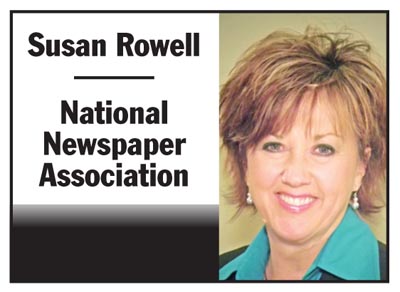Newsprint is under attack
There are two things you need to know about newspapers.
Newspapers are important to community life and democracy. Always have been. We at the  National Newspaper Association think it is important for all sorts of newspapers to survive for the sake of a free society — the very large and the very small ones, the liberal ones, the conservative ones, the middle-of-the-road ones, the ones with no viewpoint but just important news … all of them. Some are our members. Many are not. We defend them anyway. America needs them like we need oxygen.
National Newspaper Association think it is important for all sorts of newspapers to survive for the sake of a free society — the very large and the very small ones, the liberal ones, the conservative ones, the middle-of-the-road ones, the ones with no viewpoint but just important news … all of them. Some are our members. Many are not. We defend them anyway. America needs them like we need oxygen.
The second is that even if your newspaper seems to be “online,” the digital copy that you may count on probably couldn’t exist if there weren’t a printed newspaper behind it. The newspaper in print supports all of the other versions economically. So, if the printed version disappeared, you can’t assume all would be well because it is online anyway. It won’t be.
These facts are important because the paper your newspaper is printed on is under attack.
One small paper mill in Washington State is trying to use the federal trade and tariff laws to make this paper — newsprint, or uncoated groundwood paper, in paper parlance — about 50 percent more expensive. This mill has complained to the U.S. Department of Commerce and International Trade Commission about international competition. If it succeeds, the prices of newspaper printing will skyrocket. The resources available for everything else your local newspaper may need or want to do for you will be strangled.
Canadian paper producers have supplied the U.S. for many years. They have some natural advantages over U.S. papermakers because of hydroelectric power and shipping costs. More than a dozen U.S. mills have stopped making newsprint in the last decade because demand for paper has declined. Today, even if Canadian paper disappeared because of high tariffs being proposed to the federal government, the U.S. paper mills could not supply newspapers with the paper they need. Mills cost hundreds of millions of dollars to build and can take many years to be safely situated in compliance with environmental rules. With demand falling, no one is going to invest in a massive expansion of U.S. newsprint. Over the short term, tariffs could force the price of paper up and the New York investors who own the Washington State mill could gain.
But our country will lose. Fragile newspapers will vanish. Challenged newspapers will have to cut back. Even healthy newspapers are going to have to find ways to absorb a daunting new cost. And who will pay? Everyone who relies on a newspaper to tell the local stories, cover elections, advertise sales, get pictures of the winning touchdown and cheer the economic development people on in their work of creating new jobs.
That worries me. If it worries you, pay a visit to stopnewsprinttariffs.org and be informed.
Susan Rowell is president of the National Newspaper Association.



























